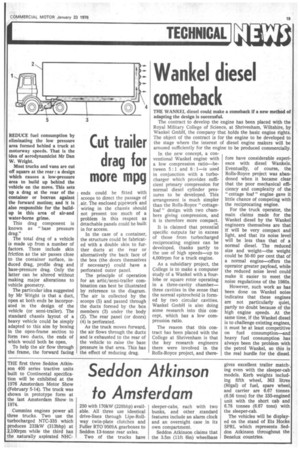Wankel diesel comeback
Page 21

If you've noticed an error in this article please click here to report it so we can fix it.
THE WANKEL diesel could make a comeback if a new method of adapting the design is successful The contract to develop the engine has been placed with the Royal Military College of Science, at Shrivenham, Wiltshire, by Wankel GmbH, the company that holds the basic engine rights. The object of the contract is for the engine to be developed to the stage where the interest of diesel engine makers will be aroused sufficiently for the engine to be produced commercially.
In the new concept, a conventional Wankel engine with a low compression ratio—between 5: 1 and 8: 1—is used in conjunction with a turbocharger which provides sufficient primary compression for normal diesel cylinder pressures to be developed. This arrangement is much simpler than the Rolls-Royce " cottageloaf " design with two chambers giving compression, and it is therefore more compact.
It is claimed that potential specific outputs far in excess of those from turbocharged reciprocating engines can be developed, thanks partly to the use of high speeds—up to 4,000rpm for a truck engine.
As a subsidiary project, the College is to make a computer study of a Wankel with a fourlobe or square rotor operating in a three-cavity chamber— three cavities in the sense that the normal epitrochoid is formed by two circular cavities. Wankel GmbH is also doing some research into this concept, which has a low compression ratio.
The reason that this contract has been placed with the College at Shrivenham is that the key research engineers there were involved in the Rolls-Royce project, and there fore have considerable experience with diesel Wankels. Eventually, of course, the Rolls-Royce project was abandoned when it became clear that the poor mechanical efficiency and complexity of the "cottage loaf" engine gave it little chance of competing with the reciprocating engine.
For the truck operator, the main claims made for the Wankel diesel by the Wankel engineers themselves are that it will be very compact and light, and that its noise level will be less than that of a normal diesel. The reduced size and weight—the weight could be 50-60 per cent that of a normal engine—offers the operator greater payload, while the reduced noise level could make it easier to meet the noise regulations of the 1980s.
However, such work as has been done on Wankel noise indicates that these engines are not particularly quiet, partly no doubt because of the high engine speeds. At the same time, if the Wankel diesel is to challenge existing engines, it must be at least competitive on fuel consumption—and heavy fuel consumption has always been the problem with the petrol Wankel, so this is the real hurdle for the diesel.
















































































